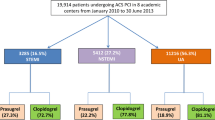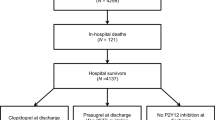Abstract
The present postmarketing surveillance investigated the safety and efficacy of clopidogrel for prevention of cardiovascular events following percutaneous coronary intervention (PCI) in a real-life setting with a large patient population. This study included patients with non-ST-segment elevation acute coronary syndrome (NSTE-ACS) who had unstable angina, and patients with non-ST-segment elevation myocardial infarction, stable angina, and old myocardial infarction (SA/OMI), or ST-segment elevation myocardial infarction (STEMI). For safety assessment in 4049 patients, the incidence of adverse drug reactions (ADR) and bleeding adverse events (AE), and for efficacy assessment in 3900 patients, that of major adverse cardiovascular events (MACE) and MACE and cerebrovascular events (MACCE), was calculated in the primary diagnosis groups (NSTE-ACS, SA/OMI, or STEMI). ADR incidence did not significantly differ by group (10.1, 11.6, and 12.2 % in the NSTE-ACS, SA/OMI, and STEMI groups, respectively). Cumulative ADR incidence was highest in the STEMI for 52 weeks. Both total and cumulative bleeding AE incidences were higher in the SA/OMI group (5.9 and 6.8 %, respectively) than in the other groups (3.5 and 3.8 % in the NSTE-ACS, 3.6 and 4.5 % in the STEMI). The MACCE and MACE incidence rates were higher in the STEMI groups than in the other groups. In conclusion, we did not find additional concerns regarding safety and efficacy of clopidogrel in patients who have undergone PCI, regardless of their diagnoses.





Similar content being viewed by others
References
Levine GN, Bates ER, Blankenship JC, Bailey SR, Bittl JA, Cercek B, et al. ACCF/AHA/SCAI guideline for Percutaneous Coronary Intervention: a report of the American College of Cardiology Foundation/American Heart Association Task Force on Practice Guidelines and the Society for Cardiovascular Angiography and Interventions. Circulation. 2011;2011(124):e574–651.
Smith SC Jr, Benjamin EJ, Bonow RO, Braun LT, Creager MA, Franklin BA, et al. AHA/ACCF Secondary Prevention and Risk Reduction Therapy for Patients with Coronary and other Atherosclerotic Vascular Disease: 2011 update: a guideline from the American Heart Association and American College of Cardiology Foundation. J Am Coll Cardiol. 2011;58:2432–46.
Guideline for diagnosis and treatment of cardiovascular disease (2010). Guidelines for elective percutaneous coronary intervention in patients with stable coronary disease (JCS 2011).
Guideline for diagnosis and treatment of cardiovascular disease (2006–2007). Guidelines for the management of patients with ST-elevation myocardial infarction (JCS 2008).
Plavix® (clopidogrel sulfate tablet) package insert (ver. 15), revised Jan 2015. Sanofi K.K.
Nakamura M, Yamagishi M, Ueno T, Hara K, Ishiwata S, Itoh T, et al. Current antiplatelet therapy for Japanese patients with ST elevation acute myocardial infarction: J-AMI registry. Cardiovasc Interv Ther. 2013;28:162–9.
Isshiki T, Kimura T, Ueno T, Nakamura M, Igarashi K, Yokoi H, et al. Clopidogrel trial in patients with elective percutaneous coronary intervention for stable angina and old myocardial infarction (CLEAN). Int Heart J. 2012;53:91–101.
Yusuf S, Zhao F, Mehta SR, Chrolavicius S, Tognoni G, Fox KK. Effects of clopidogrel in addition to aspirin in patients with acute coronary syndromes without ST-segment elevation. The clopidogrel in unstable angina to prevent recurrent events trial investigators. N Engl J Med. 2001;345:494–502.
Bhatt DL, Fox KA, Hacke W, Berger PB, Black HR, Boden WE, et al. CHARISMA Investigators. Clopidogrel and aspirin versus aspirin alone for the prevention of atherothrombotic events. N Engl J Med. 2006;354:1706–17.
Serebruany VL, Malinin AI, Eisert RM, Sane DC. Risk of bleeding complications with antiplatelet agents: meta-analysis of 338,191 patients enrolled in 50 randomized controlled trials. Am J Hematol. 2004;75:40–7.
Morino Y, Ako J, Kobayashi M, Nakamura M. Japanese postmarketing surveillance of clopidogrel for patients with non-ST-segment-elevation acute coronary syndrome indicated for percutaneous coronary intervention (J-PLACE NSTE-ACS). Cardiovasc Interv Ther. 2014;29:123–33.
James S, Budaj A, Aylward P, Buck KK, Cannon CP, Cornel JH, et al. Ticagrelor versus clopidogrel in acute coronary syndromes in relation to renal function: results from the Platelet Inhibition and Patient Outcomes (PLATO) trial. Circulation. 2010;122:1056–67.
Moscucci M, Fox KA, Cannon CP, Klein W, López-Sendón J, Montalescot G, et al. Predictors of major bleeding in acute coronary syndromes: the Global Registry of Acute Coronary Events (GRACE). Eur Heart J. 2003;24:1815–23.
Steg PG, Huber K, Andreotti F, Arnesen H, Atar D, Badimon L, et al. Bleeding in acute coronary syndromes and percutaneous coronary interventions: position paper by the Working Group on Thrombosis of the European Society of Cardiology. Eur Heart J. 2011;32:1854–64.
Subherwal S, Bach RG, Chen AY, Gage BF, Rao SV, Newby LK, et al. Baseline risk of major bleeding in non-ST-segment-elevation myocardial infarction: the CRUSADE (Can Rapid risk stratification of Unstable angina patients Suppress ADverse outcomes with Early implementation of the ACC/AHA Guidelines) Bleeding Score. Circulation. 2009;119:1873–82.
Manoukian SV, Feit F, Mehran R, Voeltz MD, Ebrahimi R, Hamon M, et al. Impact of major bleeding on 30-day mortality and clinical outcomes in patients with acute coronary syndromes: an analysis from the ACUITY Trial. J Am Coll Cardiol. 2007;49:1362–8.
Dangas GD, Caixeta A, Mehran R, Parise H, Lansky AJ, Cristea E, et al. Harmonizing Outcomes With Revascularization and Stents in Acute Myocardial Infarction (HORIZONS-AMI) Trial Investigators. Frequency and predictors of stent thrombosis after percutaneous coronary intervention in acute myocardial infarction. Circulation. 2011;123:1745–56.
Lagerqvist B, Carlsson J, Fröbert O, Lindbäck J, Scherstén F, Stenestrand U, et al. Swedish Coronary Angiography and Angioplasty Registry Study Group. Stent thrombosis in Sweden: a report from the Swedish Coronary Angiography and Angioplasty Registry. Circ Cardiovasc Intervent. 2009;2:401–8.
Daida H, Miyauchi K, Ogawa H, Yokoi H, Matsumoto M, Kitakaze M, et al. PACIFIC investigators. Management and two-year long-term clinical outcome of acute coronary syndrome in Japan: prevention of atherothrombotic incidents following ischemic coronary attack (PACIFIC) registry. Circ J. 2013;77:934–43.
Acknowledgments
The authors are grateful to all the physicians who participated in this study for their cooperation and provision of valuable data.
Author contributions
The study was conducted by Sanofi K.K. Statistical analysis was conducted by CMIC Co., Ltd. Editorial support was provided by Clinical study support, Inc., under a contract with Sanofi K.K. All the authors reviewed and revised the analysis and interpretation of the data and manuscript.
Author information
Authors and Affiliations
Corresponding author
Ethics declarations
Conflict of interest
JA, YM, and MN received consultant fees and remuneration (lectures) from Sanofi K.K. MN received manuscript fees from Sanofi K.K. YM received research funding from Sanofi K.K. KO and MU are employees of Sanofi K.K.
Ethical approval
All procedures performed in this post-marketing surveillance were in accordance with GPSP, as authorized by the Japanese Health Authority.
Informed consent
Informed consent was not mandatory, as this study was in accordance with GPSP. However, data were collected anonymously to protect personal information. There was no access to personal medical records by the sponsor.
Electronic supplementary material
Below is the link to the electronic supplementary material.
Rights and permissions
About this article
Cite this article
Ako, J., Morino, Y., Okuizumi, K. et al. Japanese postmarketing surveillance of clopidogrel in patients with non-ST-segment elevation acute coronary syndrome, stable angina, old myocardial infarction, and ST-segment elevation myocardial infarction after percutaneous coronary intervention in a real-life setting: the final report (J-PLACE Final). Cardiovasc Interv and Ther 31, 101–113 (2016). https://doi.org/10.1007/s12928-015-0355-z
Received:
Accepted:
Published:
Issue Date:
DOI: https://doi.org/10.1007/s12928-015-0355-z




